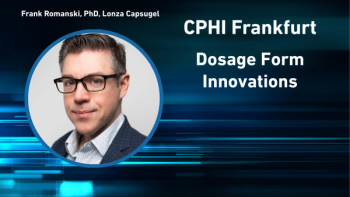
Equipment and Processing Report
- Equipment and Processing Report-09-17-2014
- Volume 0
- Issue 0
Need for Particle Engineering Increases
Micronization and other processes are used to obtain optimal particle characteristics for pulmonary and oral solid-dosage delivery.
Particle engineering, which involves obtaining the optimal particle size and size distribution as well as other aspects of the particle's morphology and surface characteristics, is used to improve bioavailability and homogeneity for oral solid-dosage drugs and to prepare inhaled therapies. Micronization is the most widely used size-reduction technique, but other technologies include spray drying, wet polishing, and supercritical fluid processing.
Delivering drugs directly to the lungs is widely used for local delivery of pulmonary drugs (e.g., for asthma) and is also beginning to be used for systemic delivery as an alternative to oral solid-dose and parenteral drugs. "The increasing popularity of pulmonary delivery can be linked to increasing evidence for the viability of this route of delivery, not only for small molecular weight drug substances but for biotech-derived therapeutic agents and higher molecular weight drugs such as peptides," says Peter York, chief scientist at CrystecPharma. "In addition, there is growing awareness that inhalation can be an attractive option when rapid onset of action is required via systemic distribution."
For systemic delivery, the pulmonary route has the advantage over oral delivery of bypassing hepatic first-pass metabolism, notes Bill Schachtner, associate director, Small Molecule and Inhalation Product Testing Services, PPD. Compared to injectable drugs, inhaled drugs have advantages of patient preference, reduced manufacturing requirements, and reduced need for cold-chain storage, he adds.
The pulmonary route offers the potential to deliver molecules that would otherwise require parenteral administration, add sources from Hovione. Compared to parenteral administration, pulmonary drug delivery is a convenient, less intrusive alternative, reducing the need for medically trained staff-supervised drug delivery and the cost of producing a sterile drug product. When compared to the oral route, pulmonary drug delivery can use a lower dose with the potential for reduced side effects, they note.
Particle-engineering methods
Particle size is crucial for pulmonary delivery because particles that are too large (> 5 micron) will not go deep into the lungs and those that are too small (< 1 micron) may be exhaled (1). Micronization using jet mills is the most common method of particle size reduction for drug particle engineering, for both oral solid-dosage and inhaled therapies. Micronization is simple, well-established, does not use solvents, and can be used for thermally sensitive materials. However, particles may have amorphous regions that crystallize over time, and particles can be difficult to disperse because of electrostatic charges (1).
Alternative processes engineer particles by drying them from solution. Emulsion systems create a narrow particle-size distribution, but require high levels of solvents (1).
Spray drying can be used to engineer particles with specific densities and particle sizes. Because the process uses heat, it is not suitable for some thermally sensitive materials (1).
Supercritical-fluid (SCF) antisolvent processing employs a supercritical fluid, typically carbon dioxide, as an antisolvent for a solution feed of drug in an organic solvent. The organic solvent is rapidly extracted by and dissolved in the supercritical fluid, and ultra-fine, crystalline micron-sized particles precipitate rapidly, explains York. By changing the processing conditions, particle engineering and tuning of particle characteristics can be achieved. The process is thus especially suitable for forming engineered particles for inhaled medicines, both in suspension metered dose inhalers and dry powder inhalers, says York. The main advantages over other technologies are that highly crystalline and stable particles are formed, and processing from drug solution to dry particle is a single-step process. In addition the process is highly reproducible and readily scaled, and the drug substance is not exposed to heat, which is an important factor when handling biotechnology-derived drugs, he adds.
Wet-polishing uses a combination of size-reduction technologies and isolation approaches, explained sources from Hovione. The technique can produce specific particle sizes with a precision of ± 0.1 µm and narrow size distribution (1). The process creates highly crystalline particles with low cohesivity.
Co-crystallization is a new technology that uses novel excipients and processes to create particles of the required size while incorporating excipients to enhance delivery to the lung, explains Schachtner. While some co-crystallization processes use available equipment, other processes use novel equipment. This technology is not yet used for commercially available products.
Reference
1.
Articles in this issue
about 11 years ago
Software Module Prints and Verifies Serialization Codesabout 11 years ago
Diagnosing Facility Mold Infectionabout 11 years ago
Protecting Temperature-Sensitive Pharmaceuticalsabout 11 years ago
Case Packer Meets Track-and-Trace RequirementsNewsletter
Get the essential updates shaping the future of pharma manufacturing and compliance—subscribe today to Pharmaceutical Technology and never miss a breakthrough.




